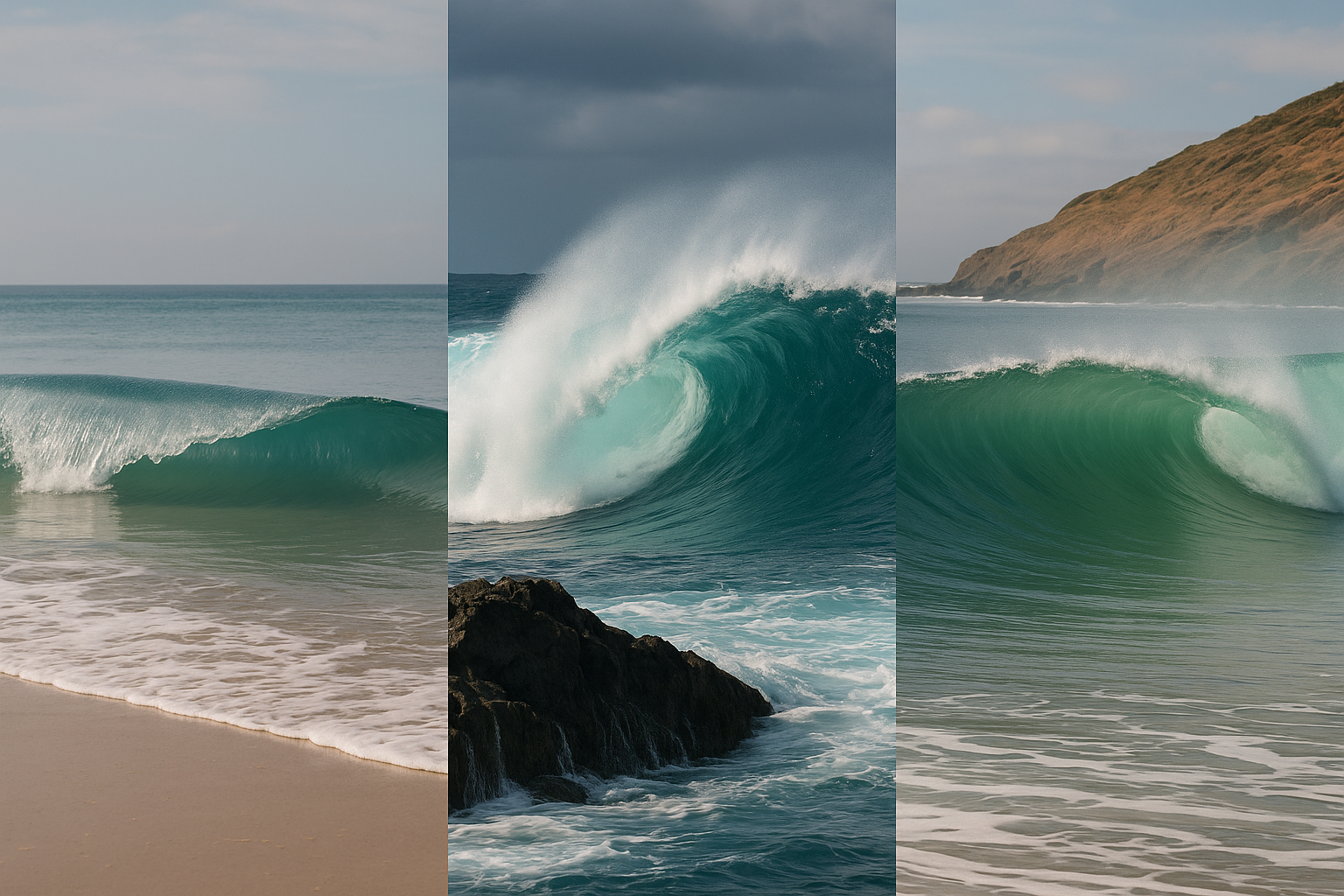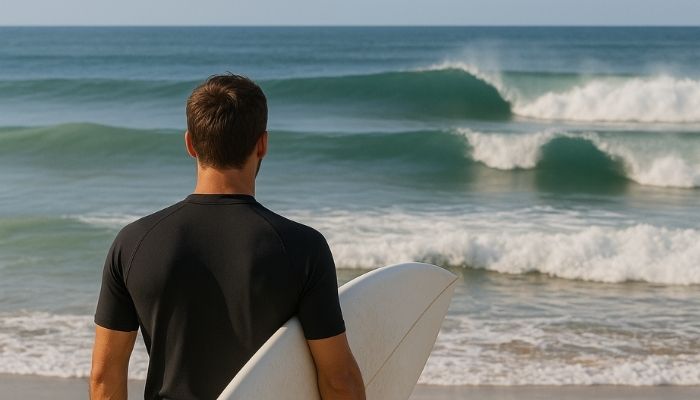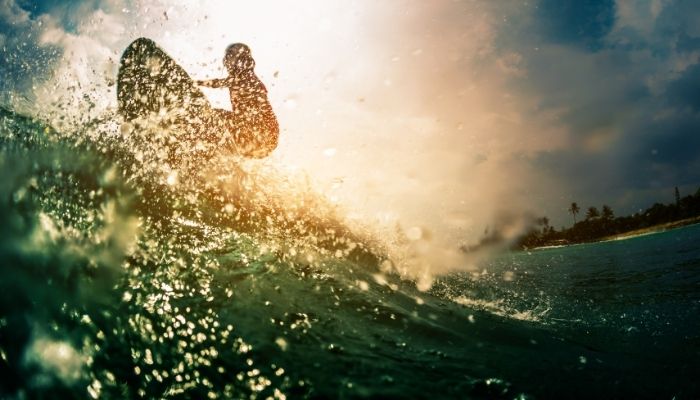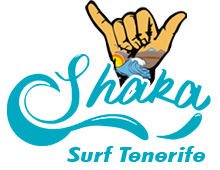
Types of Surf Waves Every Surfer Should Know
Have you ever had one of those days in the water where you give it your all… and still don’t manage to catch a decent wave? Don’t worry — it’s not always about technique. Many times, it’s simply that you’re facing the kind of wave that doesn’t suit you. That’s why knowing the different types of surf waves is key.
Keep in mind that each wave has its own personality, and getting to know them can help you choose better where, when and how to surf.
If you want to progress faster, enjoy the sea more, or simply understand what’s happening out there, this article is for you.
Why Is It So Important to Know the Types of Surf Waves?
From the shore, all waves may look the same — but if you’re going into the water, whether for the first time or after many sessions, you need to know that not all waves behave alike.
Some are soft and easy, others fast and powerful, and each one demands a different approach. Understanding the types of surf waves helps you choose better spots, adapt to what the ocean gives you, and — above all — enjoy each session more.
Knowing waves is also crucial for your safety.
Being able to tell a hollow wave from a shorebreak, for example, can save you a real scare. It also gives you confidence: helping you predict how a wave will move, read the peak, and make quick decisions in the water.
And if you’re already an experienced surfer, identifying each type correctly allows you to evolve and face more challenging conditions.
Classification by Seabed Type: Where Do Waves Break?
When you see a perfect breaking wave and imagine gliding down it, there’s one key detail you’re probably not seeing… what’s underneath.
The seabed plays a direct role in how each wave forms and breaks, and understanding this can really help you choose the right spot — whether you’re starting out or looking to improve your technique.
In general, waves are classified into three types according to the seabed where they break: sand, reef, or point.
Beach Break (Sand Bottom)
These waves break over sandbanks, meaning they tend to change with the tides and shifting seabed. They can be unpredictable, yes — but also gentler and safer. They’re perfect if you’re learning, regaining confidence, or just want a more relaxed and fun session.
The experience is usually calmer — ideal for those still developing their technique and balance.
Reef Break (Reef or Rock Bottom)
These waves break over hard, stable bottoms, which results in more defined, powerful, and often faster waves.
Here, we’re talking about more technical and demanding surfing. These waves often have hollow sections or vertical walls that require sharp ocean-reading skills.
If you’re experienced, this type of wave is a real playground — but one that demands serious respect.
Point Break (Point of Land or Rock)
These waves break along the contour of a headland or rocky point, producing long, consistent waves. Many consider this one of the best types of waves in the world.
They’re ideal for surfers with solid board control who want to link manoeuvres or enjoy long rides. Not the best choice for beginners, though, as they can be dangerous.

Classification by Shape (Let’s Talk About the Character of Each Wave)
If the seabed determines where a wave breaks, its shape tells you how it breaks.
And yes — each wave has its own personality.
Some are calm and easy, others intense and fast, and some seem tailor-made to test even the most daring surfer. Understanding these differences helps you anticipate, adapt, and get more out of every session.
Here are the most common wave shapes you’ll see in the water:
Whitewater
These are waves that have already broken and move forward as a mass of white foam. Perfect for beginners, as they have little power and let you practise without worrying too much about balance or technique. Ideal for your first times on the board.
Soft Waves
They don’t have much slope or power. They’re gentle, rounded and, at times, a bit lazy. Perfect for relaxed sessions or practising take-offs without pressure.
They might not be thrilling for advanced surfers, but they’re still useful for fine-tuning techniques and keeping the rhythm.
Shorebreak Waves
As the name suggests, these break very close to the shore and, while they might look harmless, they can be treacherous if you fall badly or hit the bottom. Common on shallow beaches, they often fool people into thinking they’re easy due to their size.
Only ideal for very short manoeuvres or a quick dip… but with caution.
Sandbar Waves
These break along a defined line (the “bar”) and can offer nice walls for manoeuvres — especially if there’s a bit of power behind them.
They tend to be more consistent and can offer interesting sections, especially when the sandy bottom is well-formed. Here, you can start enjoying longer rides without much risk, as they’re a bit more predictable.
Hollow and Barrel Waves
The most coveted by advanced surfers. These waves break with force, forming a hollow or barrel you can tuck into — if you’ve got the technique (and the nerve).
They’re fast, powerful, and demanding — but offer a one-of-a-kind experience. This type of wave requires precise ocean-reading and a well-timed entry. There’s no improvising here.
Wave Direction: Lefts, Rights and Peaks
You already know about the seabeds and the shapes, but there’s one last key detail that heavily affects how you surf: the direction the wave breaks. It might seem minor at first, but it completely changes how you read the sea and plan your ride.
Left-hand waves break to the left from the surfer’s point of view when catching the wave — meaning you’ll turn your board left as you ride. The opposite happens with right-hand waves, which push you to the right. And if a wave breaks in both directions? You’ve got a peak — a true gem for any surfer because it lets you choose your direction.
Knowing which way a wave breaks helps you position yourself better, choose your line, and plan your manoeuvres. It also helps you decide if a spot suits your style or your dominant stance (goofy or regular). It’s a technical detail, yes — but one that can make the difference between just being in the water… or truly flowing with it.
Now that you know how waves are classified by seabed, shape and direction, you’re much better equipped to connect with the ocean in a new way.
Whether you’re a beginner, curious, or a seasoned surfer, understanding these elements will help you enjoy every session more, get the most out of your level, and move with greater confidence.
Remember: it’s not always about finding the perfect wave — it’s about knowing what to do with the one right in front of you.

So… Ready to Try It for Yourself?
Now that you know how to identify wave types, there’s only one thing left: live it in the water. Because reading about surfing is great… but feeling that first wave? Nothing compares.
At Shaka Surf School, we make it easy to take that step. Whether it’s your first time or you want to keep progressing, we’ve got waves — and good vibes — for every level.
See you in the water?

